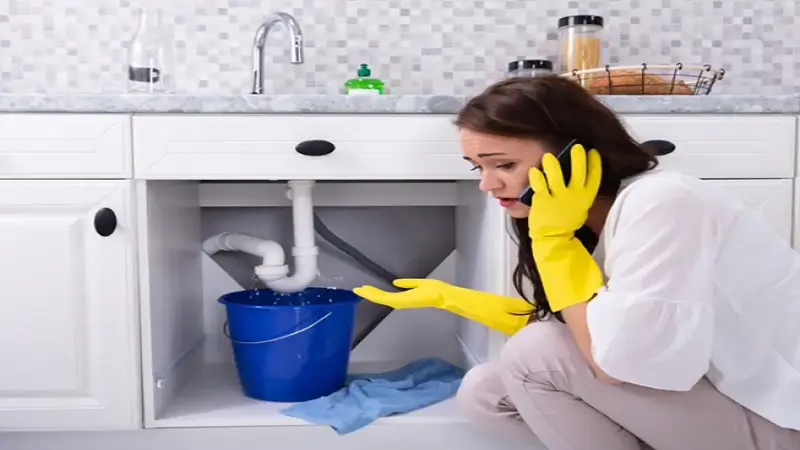Water damage in the kitchen can be a homeowner’s worst nightmare. From leaking appliances to burst pipes, the potential for extensive damage is significant. In this comprehensive guide, we will explore proactive measures to prevent water damage and effective strategies for restoration if damage occurs. Our goal is to equip you with the knowledge and tools necessary to protect your kitchen from water-related disasters.
Understanding the Causes of Kitchen Water Damage
Leaky Faucets and Pipes
One of the most common sources of water damage in the kitchen is leaky faucets and pipes. Over time, seals and washers can wear out, leading to drips and leaks that, if left unattended, can cause substantial damage.
Appliance Failures
Dishwashers, refrigerators, and washing machines are prime culprits when it comes to water damage. Aging hoses and faulty connections can lead to significant water leaks, often going unnoticed until the damage is done.
Clogged Drains
Clogged drains can cause water to back up and overflow, especially in kitchen sinks. Food debris, grease, and other particles can build up over time, leading to blockages that prevent proper drainage.
Roof and Window Leaks
While less common, leaks from the roof or around windows can also contribute to kitchen water damage. These leaks often manifest during heavy rainstorms or due to poor sealing around windows.
Preventive Measures for Kitchen Water Damage
Regular Inspections
Conducting regular inspections of your kitchen plumbing and appliances is essential. Check under sinks, around appliances, and in any visible piping areas for signs of moisture or leaks.
Install Water Detection Devices
Water detection devices can be a game-changer in preventing extensive water damage. These devices alert you to the presence of water in areas where it shouldn’t be, giving you a chance to address the issue before it becomes severe.
Maintain Appliances
Regular maintenance of kitchen appliances is crucial. Replace aging hoses and inspect connections to ensure they are secure. For dishwashers and washing machines, consider using stainless steel braided hoses, which are more durable than rubber ones.
Proper Drain Care
Preventing clogs is easier than dealing with them after they occur. Use drain guards to catch debris and regularly flush your drains with hot water to prevent buildup. Avoid pouring grease down the sink, as it can solidify and cause blockages.
Seal Windows and Roofs
Ensure that windows and roofs are properly sealed to prevent water from seeping into your kitchen. Regularly inspect and maintain these seals, especially after severe weather events.
Steps to Restore Kitchen Water Damage
Safety First
Before addressing water damage, ensure that it is safe to do so. Turn off the electricity to the affected area to avoid electrical hazards.
Remove Standing Water
The first step in restoration is to remove any standing water. Use a wet/dry vacuum, mop, or towels to soak up the water. The quicker you remove the water, the less damage it will cause.
Dry the Affected Area
Drying the affected area thoroughly is crucial. Use fans, dehumidifiers, and open windows to promote airflow and reduce moisture. This step helps prevent mold growth, which can occur within 24-48 hours of water exposure.
Inspect and Clean
Inspect all affected areas for damage. This includes checking cabinets, floors, walls, and any other structures. Clean and disinfect these areas to remove any contaminants the water may have brought in.
Repair and Restore
Depending on the extent of the damage, you may need to repair or replace damaged materials. This can include replacing drywall, flooring, or cabinetry. Ensure that the area is completely dry before making any repairs to avoid trapping moisture.
Prevent Mold Growth
To prevent mold growth, consider using mold-resistant products during your repairs. Regularly monitor the area for signs of mold and address any issues promptly.
Additional Tips for Kitchen Water Damage Prevention
Install a Sump Pump
If your kitchen is prone to flooding, especially in basements, consider installing a sump pump. This device helps to remove water that accumulates in a sump basin, keeping your kitchen dry.
Insulate Pipes
Insulating your pipes can prevent them from freezing and bursting during colder months. Pipe insulation is an affordable and effective way to reduce the risk of water damage.
Regular Maintenance
Regular maintenance of your kitchen’s plumbing system is essential. Schedule annual inspections with a professional plumber to identify and address potential issues before they become major problems.
Upgrade Old Plumbing
If your home has old plumbing, consider upgrading to modern, more reliable materials. Copper and PEX piping are more durable and less prone to leaks compared to older materials like galvanized steel.
Conclusion
Kitchen water damage can be a costly and disruptive problem, but with the right preventive measures and restoration strategies, you can protect your home and minimize the impact. By conducting regular inspections, maintaining appliances, and taking proactive steps to prevent leaks, you can keep your kitchen safe from water damage. If damage does occur, act quickly to remove water, dry the area, and repair any damage to prevent further issues like mold growth. With vigilance and proper care, your kitchen can remain a safe and dry environment for your family.
